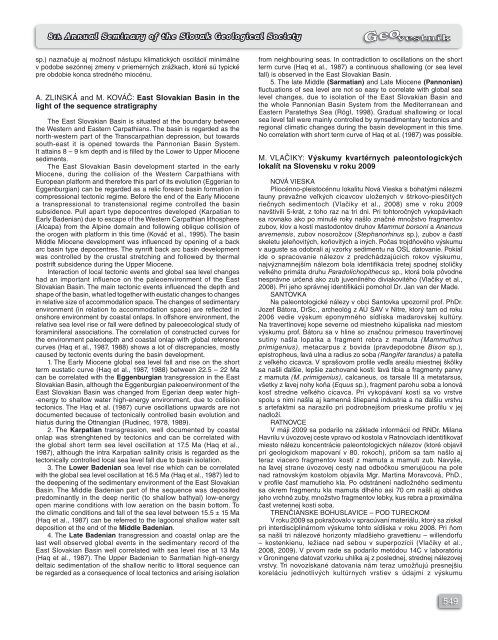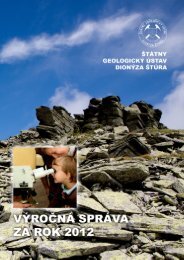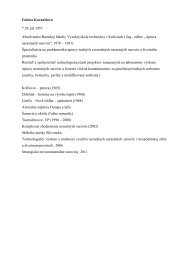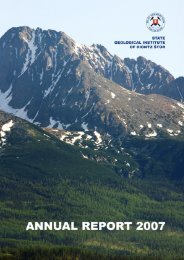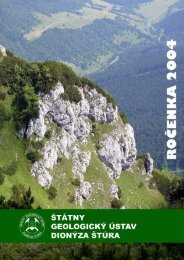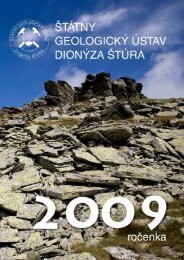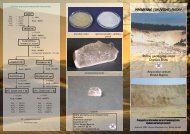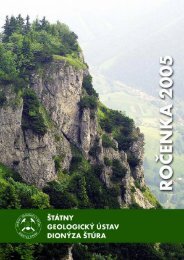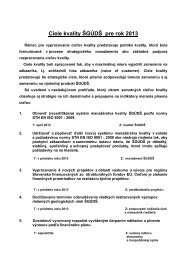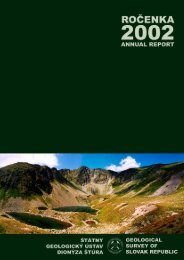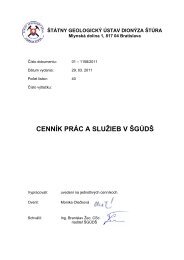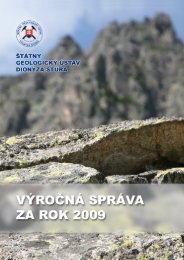Németh, Z., Plašienka, D., Šimon, L., Kohút, M - Štátny geologický ...
Németh, Z., Plašienka, D., Šimon, L., Kohút, M - Štátny geologický ...
Németh, Z., Plašienka, D., Šimon, L., Kohút, M - Štátny geologický ...
Create successful ePaper yourself
Turn your PDF publications into a flip-book with our unique Google optimized e-Paper software.
8 th Annual Seminary of the Slovak Geological Society<br />
sp.) naznačuje aj možnosť nástupu klimatických oscilácií minimálne<br />
v podobe sezónnej zmeny v priemerných zrážkach, ktoré sú typické<br />
pre obdobie konca stredného miocénu.<br />
A. ZLINSKÁ and M. KOVÁČ: East Slovakian Basin in the<br />
light of the sequence stratigraphy<br />
The East Slovakian Basin is situated at the boundary between<br />
the Western and Eastern Carpathians. The basin is regarded as the<br />
north-western part of the Transcarpathian depression, but towards<br />
south-east it is opened towards the Pannonian Basin System.<br />
It attains 8 – 9 km depth and is filled by the Lower to Upper Miocene<br />
sediments.<br />
The East Slovakian Basin development started in the early<br />
Miocene, during the collision of the Western Carpathians with<br />
European platform and therefore this part of its evolution (Eggerian to<br />
Eggenburgian) can be regarded as a relic forearc basin formation in<br />
compressional tectonic regime. Before the end of the Early Miocene<br />
a transpressional to transtensional regime controlled the basin<br />
subsidence. Pull apart type depocentres developed (Karpatian to<br />
Early Badenian) due to escape of the Western Carpathian lithosphere<br />
(Alcapa) from the Alpine domain and following oblique collision of<br />
the orogen with platform in this time (Kováč et al., 1995). The basin<br />
Middle Miocene development was influenced by opening of a back<br />
arc basin type depocentres. The synrift back arc basin development<br />
was controlled by the crustal stretching and followed by thermal<br />
postrift subsidence during the Upper Miocene.<br />
Interaction of local tectonic events and global sea level changes<br />
had an important influence on the paleoenvironment of the East<br />
Slovakian Basin. The main tectonic events influenced the depth and<br />
shape of the basin, what led together with eustatic changes to changes<br />
in relative size of accommodation space. The changes of sedimentary<br />
environment (in relation to accommodation space) are reflected in<br />
onshore environment by coastal onlaps. In offshore environment, the<br />
relative sea level rise or fall were defined by paleoecological study of<br />
foraminiferal associations. The correlation of constructed curves for<br />
the environment paleodepth and coastal onlap with global reference<br />
curves (Haq et al., 1987, 1988) shows a lot of discrepancies, mostly<br />
caused by tectonic events during the basin development.<br />
1. The Early Miocene global sea level fall and rise on the short<br />
term eustatic curve (Haq et al., 1987, 1988) between 22.5 – 22 Ma<br />
can be correlated with the Eggenburgian transgression in the East<br />
Slovakian Basin, although the Eggenburgian paleoenvironment of the<br />
East Slovakian Basin was changed from Egerian deep water high-<br />
-energy to shallow water high-energy environment, due to collision<br />
tectonics. The Haq et al. (1987) curve oscillations upwards are not<br />
documented because of tectonically controlled basin evolution and<br />
hiatus during the Ottnangian (Rudinec, 1978, 1989).<br />
2. The Karpatian transgression, well documented by coastal<br />
onlap was strenghtened by tectonics and can be correlated with<br />
the global short term sea level oscillation at 17.5 Ma (Haq et al.,<br />
1987), although the intra Karpatian salinity crisis is regarded as the<br />
tectonically controlled local sea level fall due to basin isolation.<br />
3. The Lower Badenian sea level rise which can be correlated<br />
with the global sea level oscillation at 16.5 Ma (Haq et al., 1987) led to<br />
the deepening of the sedimentary environment of the East Slovakian<br />
Basin. The Middle Badenian part of the sequence was deposited<br />
predominantly in the deep neritic (to shallow bathyal) low-energy<br />
open marine conditions with low aeration on the basin bottom. To<br />
the climatic conditions and fall of the sea level between 15.5 ± 15 Ma<br />
(Haq et al., 1987) can be referred to the lagoonal shallow water salt<br />
deposition et the end of the Middle Badenian.<br />
4. The Late Badenian transgression and coastal onlap are the<br />
last well observed global events in the sedimentary record of the<br />
East Slovakian Basin well correlated with sea level rise at 13 Ma<br />
(Haq et al., 1987). The Upper Badenian to Sarmatian high-energy<br />
deltaic sedimentation of the shallow neritic to littoral sequence can<br />
be regarded as a consequence of local tectonics and arising isolation<br />
from neighbouring seas. In contradiction to oscillations on the short<br />
term curve (Haq et al., 1987) a continuous shallowing (or sea level<br />
fall) is observed in the East Slovakian Basin.<br />
5. The late Middle (Sarmatian) and Late Miocene (Pannonian)<br />
fluctuations of sea level are not so easy to correlate with global sea<br />
level changes, due to isolation of the East Slovakian Basin and<br />
the whole Pannonian Basin System from the Mediterranean and<br />
Eastern Paratethys Sea (Rögl, 1998). Gradual shallowing or local<br />
sea level fall were mainly controlled by synsedimentary tectonics and<br />
regional climatic changes during the basin development in this time.<br />
No correlation with short term curve of Haq et al. (1987) was possible.<br />
M. VLAČIKY: Výskumy kvartérnych paleontologických<br />
lokalít na Slovensku v roku 2009<br />
NOVÁ VIESKA<br />
Pliocénno-pleistocénnu lokalitu Nová Vieska s bohatými nálezmi<br />
fauny prevažne veľkých cicavcov uložených v štrkovo-piesčitých<br />
riečnych sedimentoch (Vlačiky et al., 2008) sme v roku 2009<br />
navštívili 5-krát, z toho raz na tri dni. Pri tohtoročných vykopávkach<br />
sa rovnako ako po minulé roky našlo značné množstvo fragmentov<br />
zubov, klov a kostí mastodontov druhov Mammut borsoni a Anancus<br />
arvernensis, zubov nosorožcov (Stephanorhinus sp.), zubov a častí<br />
skeletu jeleňovitých, koňovitých a iných. Počas trojdňového výskumu<br />
v auguste sa odobrali aj vzorky sedimentu na OSL datovanie. Pokiaľ<br />
ide o spracovanie nálezov z predchádzajúcich rokov výskumu,<br />
najvýznamnejším nálezom bola identifikácia tretej spodnej stoličky<br />
veľkého primáta druhu Paradolichopithecus sp., ktorá bola pôvodne<br />
nesprávne určená ako zub juvenilného diviakovitého (Vlačiky et al.,<br />
2008). Pri jeho správnej identifikácii pomohol Dr. Jan van der Made.<br />
SANTOVKA<br />
Na paleontologické nálezy v obci Santovka upozornil prof. PhDr.<br />
Jozef Bátora, DrSc., archeológ z AÚ SAV v Nitre, ktorý tam od roku<br />
2006 vedie výskum eponymného sídliska maďarovskej kultúry.<br />
Na travertínovej kope severne od miestneho kúpaliska nad miestom<br />
výskumu prof. Bátoru sa v hline so značnou prímesou travertínovej<br />
sutiny našla lopatka a fragment rebra z mamuta (Mammuthus<br />
primigenius), metacarpus z bovida (pravdepodobne Bison sp.),<br />
epistropheus, ľavá ulna a radius zo soba (Rangifer tarandus) a patella<br />
z veľkého cicavca. V sprašovom profile vedľa areálu miestnej škôlky<br />
sa našli ďalšie, lepšie zachované kosti: ľavá tíbia a fragmenty panvy<br />
z mamuta (M. primigenius), calcaneus, os tarsale III a metatarsus,<br />
všetky z ľavej nohy koňa (Equus sp.), fragment parohu soba a lonová<br />
kosť stredne veľkého cicavca. Pri vykopávaní kostí sa vo vrstve<br />
spolu s nimi našla aj kamenná štiepaná industria a na ďalšiu vrstvu<br />
s artefaktmi sa narazilo pri podrobnejšom prieskume profilu v jej<br />
nadloží.<br />
RATNOVCE<br />
V máji 2009 sa podarilo na základe informácií od RNDr. Milana<br />
Havrilu v úvozovej ceste vpravo od kostola v Ratnovciach identifikovať<br />
miesto nálezu koncentrácie paleontologických nálezov (ktoré objavil<br />
pri geologickom mapovaní v 80. rokoch), pričom sa tam našlo aj<br />
teraz viacero fragmentov kostí z mamuta a mamutí zub. Navyše,<br />
na ľavej strane úvozovej cesty nad odbočkou smerujúcou na pole<br />
nad ratnovským kostolom objavila Mgr. Martina Moravcová, PhD.,<br />
v profile časť mamutieho kla. Po odstránení nadložného sedimentu<br />
sa okrem fragmentu kla mamuta dlhého asi 70 cm našli aj obidva<br />
jeho vrchné zuby, množstvo fragmentov lebky, kus rebra a proximálna<br />
časť vretennej kosti soba.<br />
TRENČIANSKE BOHUSLAVICE – POD TURECKOM<br />
V roku 2009 sa pokračovalo v spracúvaní materiálu, ktorý sa získal<br />
pri interdisciplinárnom výskume tohto sídliska v roku 2008. Pri ňom<br />
sa našli tri nálezové horizonty mladšieho gravettienu – willendorfu<br />
– kostenkienu, ležiace nad sebou v superpozícii (Vlačiky et al.,<br />
2008, 2009). V prvom rade sa podarilo metódou 14C v laboratóriu<br />
v Groningene datovať vzorku uhlíka aj z poslednej, strednej nálezovej<br />
vrstvy. Tri novozískané datovania nám teraz umožňujú presnejšiu<br />
koreláciu jednotlivých kultúrnych vrstiev s údajmi z výskumu<br />
549


